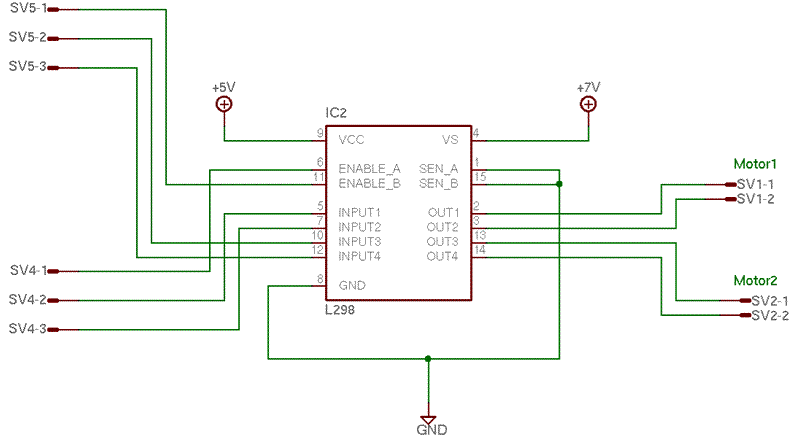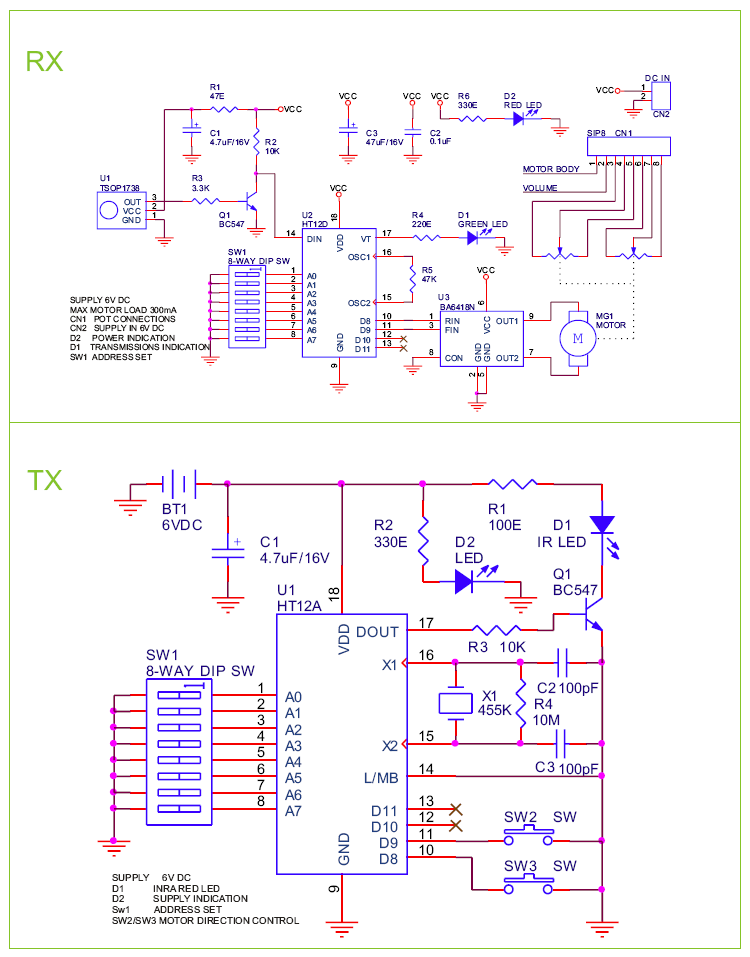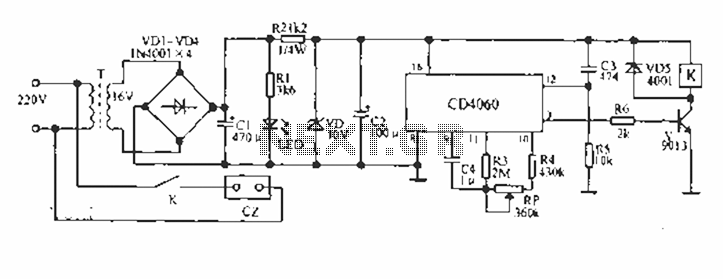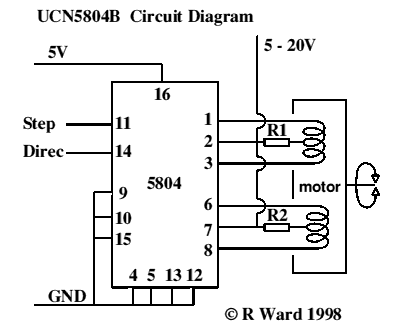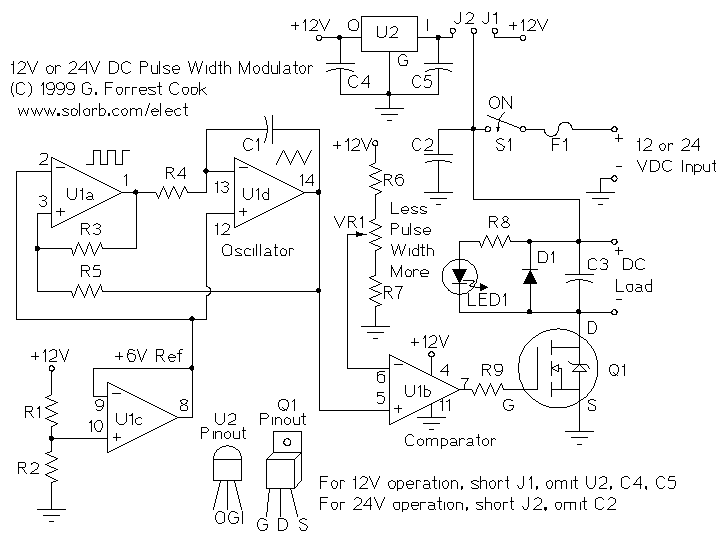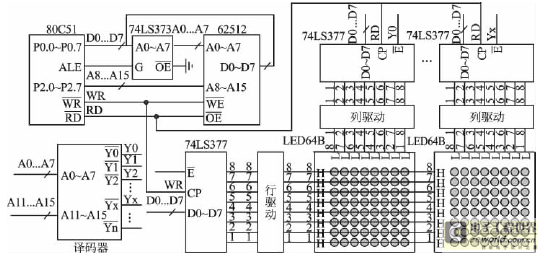
PWM motor speed controller
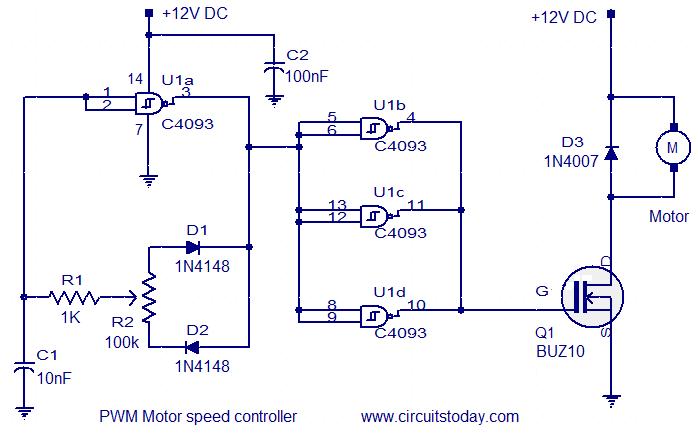
This circuit is designed based on a request from Mr. Vinoth in India. The requirement is for a 12V/5A DC fan motor controller. The circuit utilizes the quad 2-input Schmitt trigger IC CD4093 as its core component. Among the four Schmitt triggers in the CD4093, U1a is configured as an oscillator with an adjustable duty cycle. The remaining triggers, U1b, U1c, and U1d, serve to buffer the output of the oscillator, enabling it to drive the switching MOSFET Q1. The MOSFET controls the DC motor in accordance with the switching pulses generated by the oscillator. By adjusting resistor R1, the duty cycle can be modified, which in turn alters the speed of the motor. Diode D3 functions as a freewheeling diode.
The circuit operates by leveraging the characteristics of the CD4093 Schmitt trigger IC, which provides a stable output even with noisy input signals. The oscillator configuration formed by U1a generates a square wave signal whose frequency and duty cycle can be adjusted by changing the values of the timing components connected to it, typically resistors and capacitors. This square wave output is then buffered by U1b, U1c, and U1d to ensure that it can adequately drive the gate of the MOSFET Q1 without introducing significant signal degradation.
The MOSFET acts as a switch that controls the power delivered to the DC fan motor. When the gate of the MOSFET receives a high signal from the buffered output of the oscillator, it turns on, allowing current to flow through the motor. The speed of the motor is directly proportional to the duty cycle of the PWM signal; a higher duty cycle results in a higher average voltage across the motor, leading to increased speed. Conversely, a lower duty cycle reduces the average voltage and decreases the motor speed.
Diode D3 is crucial for protecting the circuit from back EMF generated by the inductive load of the motor when it is switched off. This back EMF can cause voltage spikes that may damage the MOSFET and other components. D3 allows the current generated by the motor's inductance to circulate safely, preventing damage and ensuring reliable operation.
Overall, this circuit effectively meets the specified requirements for a DC fan motor controller, providing adjustable speed control through a simple and robust design.This circuit is designed as per a request made by Mr Vinoth from India. His requirement was a 12V/5A DC fan motor controller. I think this circuit is sufficient for this purpose. Quad 2 input Schmitt trigger IC CD4093 is the heart of this circuit. Out of the four Schmitt triggers inside the 4093, U1a is wired as an oscillator with adjustable duty cycle. The U1b, U1c, U1d buffers the output of the oscillator to drive the switching MOSFET Q1. The MOSFET drives the DC motor according to the switching pulse obtained from the oscillator. When R1 is varied the duty cycle varies and so do the speed of the motor. Diode D3 acts as a freewheeling diode. 🔗 External reference
The circuit operates by leveraging the characteristics of the CD4093 Schmitt trigger IC, which provides a stable output even with noisy input signals. The oscillator configuration formed by U1a generates a square wave signal whose frequency and duty cycle can be adjusted by changing the values of the timing components connected to it, typically resistors and capacitors. This square wave output is then buffered by U1b, U1c, and U1d to ensure that it can adequately drive the gate of the MOSFET Q1 without introducing significant signal degradation.
The MOSFET acts as a switch that controls the power delivered to the DC fan motor. When the gate of the MOSFET receives a high signal from the buffered output of the oscillator, it turns on, allowing current to flow through the motor. The speed of the motor is directly proportional to the duty cycle of the PWM signal; a higher duty cycle results in a higher average voltage across the motor, leading to increased speed. Conversely, a lower duty cycle reduces the average voltage and decreases the motor speed.
Diode D3 is crucial for protecting the circuit from back EMF generated by the inductive load of the motor when it is switched off. This back EMF can cause voltage spikes that may damage the MOSFET and other components. D3 allows the current generated by the motor's inductance to circulate safely, preventing damage and ensuring reliable operation.
Overall, this circuit effectively meets the specified requirements for a DC fan motor controller, providing adjustable speed control through a simple and robust design.This circuit is designed as per a request made by Mr Vinoth from India. His requirement was a 12V/5A DC fan motor controller. I think this circuit is sufficient for this purpose. Quad 2 input Schmitt trigger IC CD4093 is the heart of this circuit. Out of the four Schmitt triggers inside the 4093, U1a is wired as an oscillator with adjustable duty cycle. The U1b, U1c, U1d buffers the output of the oscillator to drive the switching MOSFET Q1. The MOSFET drives the DC motor according to the switching pulse obtained from the oscillator. When R1 is varied the duty cycle varies and so do the speed of the motor. Diode D3 acts as a freewheeling diode. 🔗 External reference
Warning: include(partials/cookie-banner.php): Failed to open stream: Permission denied in /var/www/html/nextgr/view-circuit.php on line 713
Warning: include(): Failed opening 'partials/cookie-banner.php' for inclusion (include_path='.:/usr/share/php') in /var/www/html/nextgr/view-circuit.php on line 713
